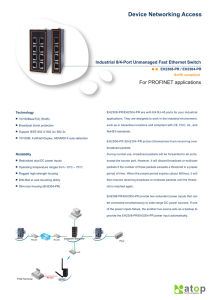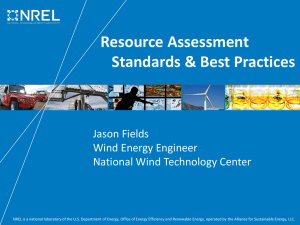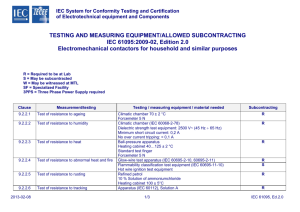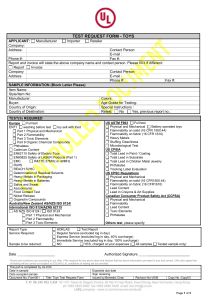21 kB
advertisement
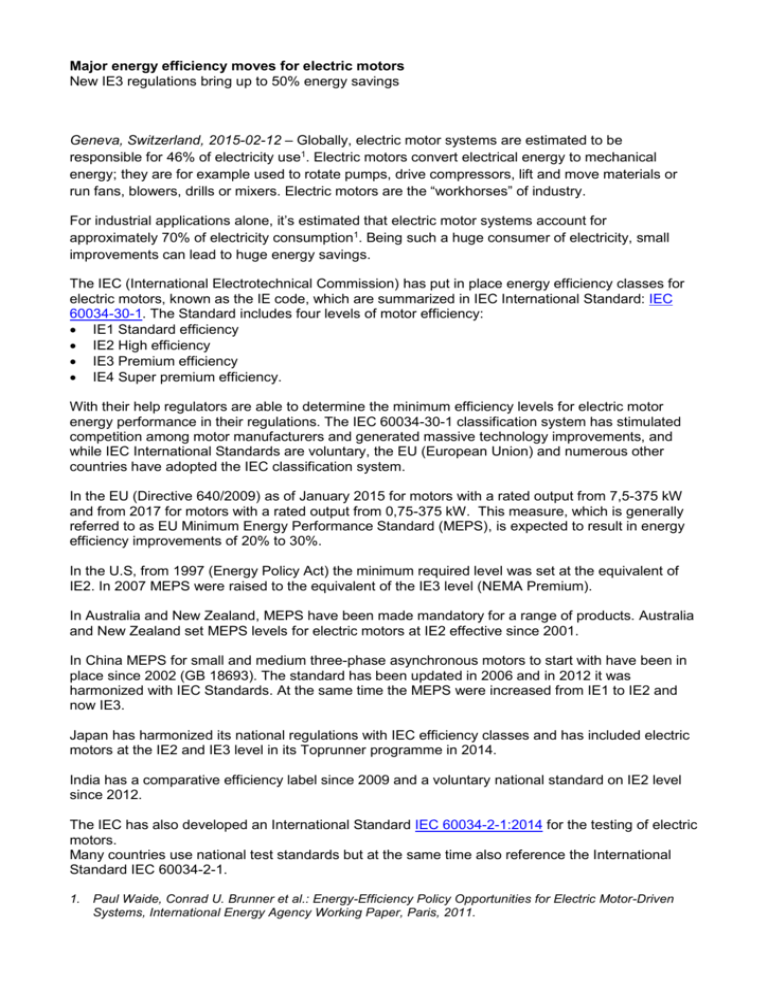
Major energy efficiency moves for electric motors New IE3 regulations bring up to 50% energy savings Geneva, Switzerland, 2015-02-12 – Globally, electric motor systems are estimated to be responsible for 46% of electricity use1. Electric motors convert electrical energy to mechanical energy; they are for example used to rotate pumps, drive compressors, lift and move materials or run fans, blowers, drills or mixers. Electric motors are the “workhorses” of industry. For industrial applications alone, it’s estimated that electric motor systems account for approximately 70% of electricity consumption1. Being such a huge consumer of electricity, small improvements can lead to huge energy savings. The IEC (International Electrotechnical Commission) has put in place energy efficiency classes for electric motors, known as the IE code, which are summarized in IEC International Standard: IEC 60034-30-1. The Standard includes four levels of motor efficiency: IE1 Standard efficiency IE2 High efficiency IE3 Premium efficiency IE4 Super premium efficiency. With their help regulators are able to determine the minimum efficiency levels for electric motor energy performance in their regulations. The IEC 60034-30-1 classification system has stimulated competition among motor manufacturers and generated massive technology improvements, and while IEC International Standards are voluntary, the EU (European Union) and numerous other countries have adopted the IEC classification system. In the EU (Directive 640/2009) as of January 2015 for motors with a rated output from 7,5-375 kW and from 2017 for motors with a rated output from 0,75-375 kW. This measure, which is generally referred to as EU Minimum Energy Performance Standard (MEPS), is expected to result in energy efficiency improvements of 20% to 30%. In the U.S, from 1997 (Energy Policy Act) the minimum required level was set at the equivalent of IE2. In 2007 MEPS were raised to the equivalent of the IE3 level (NEMA Premium). In Australia and New Zealand, MEPS have been made mandatory for a range of products. Australia and New Zealand set MEPS levels for electric motors at IE2 effective since 2001. In China MEPS for small and medium three-phase asynchronous motors to start with have been in place since 2002 (GB 18693). The standard has been updated in 2006 and in 2012 it was harmonized with IEC Standards. At the same time the MEPS were increased from IE1 to IE2 and now IE3. Japan has harmonized its national regulations with IEC efficiency classes and has included electric motors at the IE2 and IE3 level in its Toprunner programme in 2014. India has a comparative efficiency label since 2009 and a voluntary national standard on IE2 level since 2012. The IEC has also developed an International Standard IEC 60034-2-1:2014 for the testing of electric motors. Many countries use national test standards but at the same time also reference the International Standard IEC 60034-2-1. 1. Paul Waide, Conrad U. Brunner et al.: Energy-Efficiency Policy Opportunities for Electric Motor-Driven Systems, International Energy Agency Working Paper, Paris, 2011. More information IEC website section on energy efficiency in electric motors IEC 60034-30-1 ed1.0 Rotating electrical machines - Part 30-1: Efficiency classes of line operated AC motors (IE code) http://webstore.iec.ch/webstore/webstore.nsf/artnum/049306!opendocument IEC 60034-2-1:2014 Rotating electrical machines - Part 2-1: Standard methods for determining losses and efficiency from tests (excluding machines for traction vehicles) http://webstore.iec.ch/webstore/webstore.nsf/artnum/049827!opendocument TC 2 Rotating machinery http://www.iec.ch/dyn/www/f?p=103:7:0::::FSP_ORG_ID:1221 Further Information Gabriela Ehrlich Mob: +41 79 600 56 72 | Skype: gabriela.ehrlich | Email: geh@iec.ch About the IEC The IEC (International Electrotechnical Commission) brings together 166 countries, representing 98% of the world population and 96% of world energy generation, and close to 15 000 experts who cooperate on the global, neutral and independent IEC platform to ensure that products work everywhere safely with each other. The IEC is the world's leading organization that prepares and publishes globally relevant International Standards for the whole energy chain, including all electrical, electronic and related technologies, devices and systems. The IEC also supports all forms of conformity assessment and administers four Conformity Assessment Systems that certify that components, equipment and systems used in homes, offices, healthcare facilities, public spaces, transportation, manufacturing, explosive environments and energy generation conform to them. IEC work covers a vast range of technologies: power generation (including all renewable energy sources), transmission, distribution, Smart Grid & Smart Cities, batteries, home appliances, office and medical equipment, all public and private transportation, semiconductors, fibre optics, nanotechnology, multimedia, information technology, and more. It also addresses safety, EMC, performance and the environment. www.iec.ch

